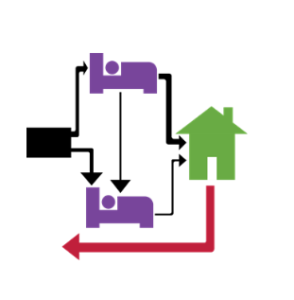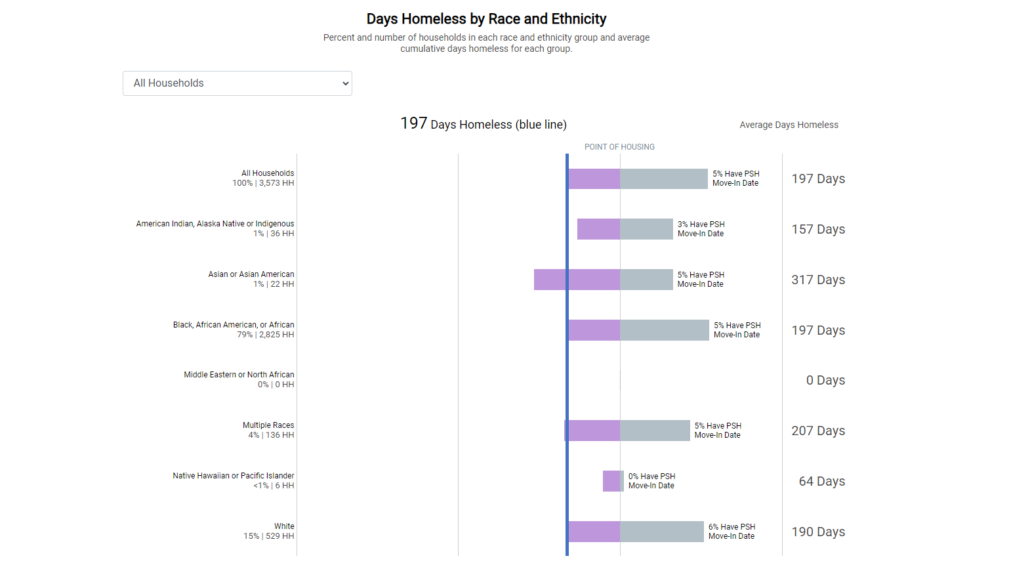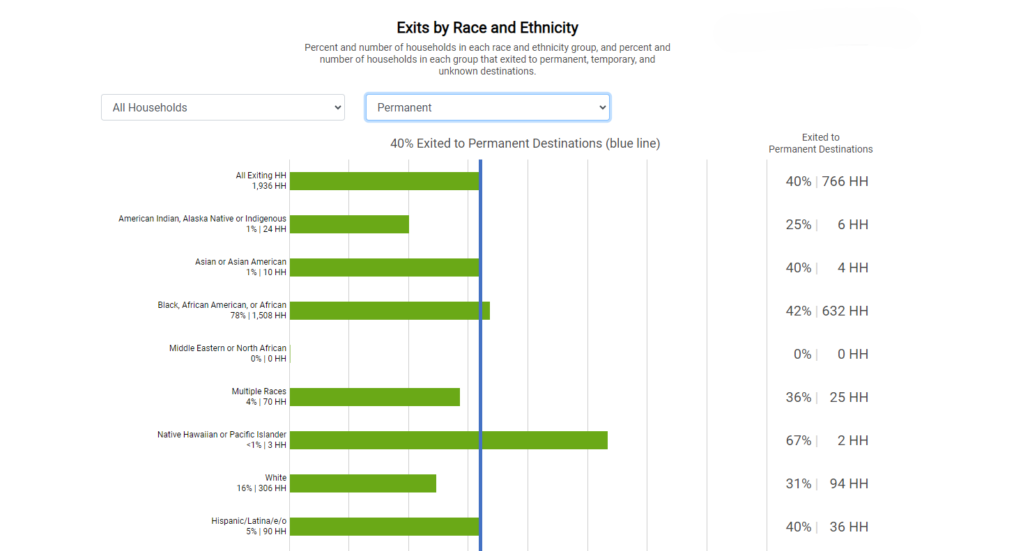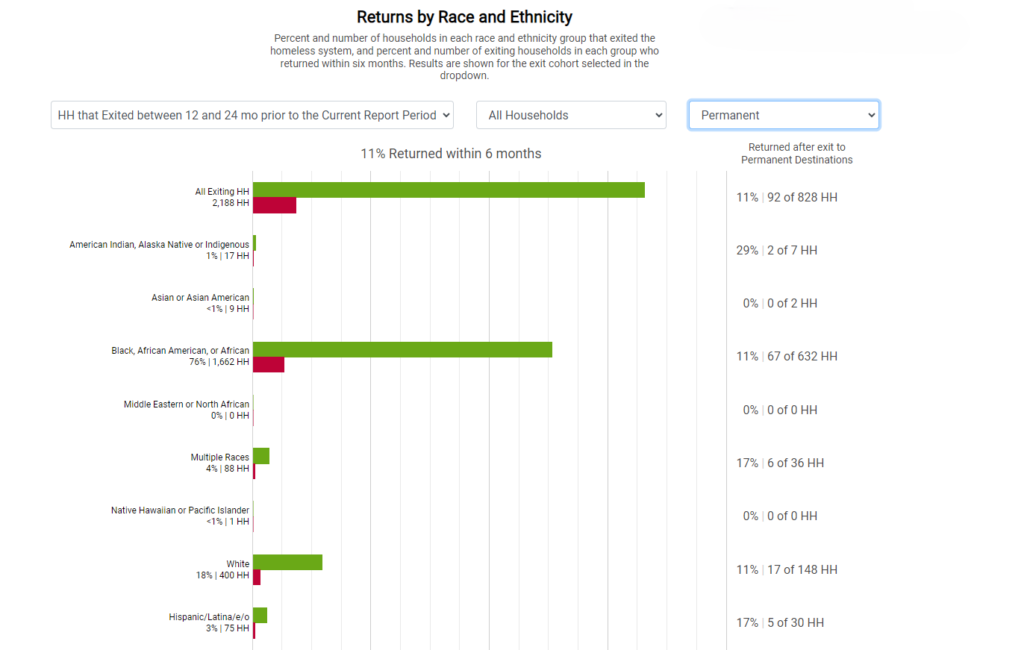Leveraging Stella P to Enhance Homeless Services Systems: Demographics
Mary Ann Priester
Senior Management Analyst
Mecklenburg County Community Support Services
The Stella Performance Module (Stella P) visualizes a homeless system’s performance using the CoC’s Longitudinal System Analysis (LSA) data. Stella P empowers communities to develop and monitor strategies to improve system performance. This blog is the fifth and final installment in a series of blogs examining Charlotte-Mecklenburg’s latest LSA data utilizing the Stella P Module.
This blog provides an overview of demographic data, disaggregated data for the LSA’s three primary metrics: days homeless, system exits, and returns to homelessness, and highlights opportunities to improve equity within the Charlotte-Mecklenburg homeless services system.
Previous blogs provided an overview of LSA data and the Stella P dashboard and system performance map, system exits, days homeless, and returns to homelessness. This blog focuses on the demographics section of Stella P and provides information on the three key metrics by race and ethnicity.
DEMOGRAPHICS
The Stella P Demographics module consists of two components: Overview and Comparison. Demographics Overview provides the total counts and demographic characteristics for households, heads of household and adults, and total people that were served by household type and by project type. Person level and household level demographic characteristics include gender, age, race and ethnicity, household composition, veteran status, domestic violence status (survivor and/or fleeing), chronic homelessness and disabling condition, system engagement, and prior living situation. The counts include households served in emergency shelter, safe haven, transitional housing, rapid rehousing, and permanent supportive housing. This module of Stella P looks at both households and person level data while all other modules only look at households.
The Comparison module of Stella P examines person level and household level demographic characteristics (gender, race, ethnicity, veteran status, chronic homelessness status, domestic violence status) of households, heads of households, and adults by household type and project type.
RACE AND ETHNICITY
The Days Homeless, Systems Exits, and Returns to Homelessness sections of Stella P all have a race and ethnicity module. The Days Homeless by Race and Ethnicity module provides the percent and number of households in each race and ethnicity group and average cumulative days homeless by each household type.
The Systems Exits by Race and Ethnicity Module provides the percent and number of households in each race and ethnicity group by household and destination type.
The Returns to Homelessness by Race and Ethnicity module provides the percent and number of households in each race and ethnicity group that exited the homeless system by household type, length of time to return, and prior exit destination.
CHARLOTTE-MECKLENBURG DEMOGRAPHICS
Overview
The Charlotte-Mecklenburg Demographics Overview module shows that overall, 55% of persons in the reporting period identified as male, 44% were adults ages 25-44, 83% identified as Black, African American, or African alone (non-Hispanic/ non-Latino), 84% were a household of 1 person, 9% were veterans, and 20% reported being survivors of domestic violence (with 5% currently fleeing). Twenty-one percent met the criteria for chronic homelessness and 57% were homeless for the first time which for the purposes of the LSA means they have not touched a homeless services agency that is included in the LSA and uses HMIS in the 24 months prior to the reporting period.
We do see differences when examining these demographic data by household type. Adult only households were 66% male, 55% were ages 25-54, 79% identified as Black, African American, or African alone (non-Hispanic/ non-Latino), 99% were a household of 1 person, 11% were veterans, and 17% reported being survivors of domestic violence (with 4% currently fleeing). Twenty-five percent met the criteria for chronic homelessness and 55% were homeless for the first time. In contrast, when examining households with minor children, 63% identified as female, 64% were children ages 0 – 17; most adults were ages 25 – 44 (29%). Ninety percent identified as Black, African American, or African alone (non-Hispanic/ non-Latino), 3% were veterans, and 38% reported being survivors of domestic violence (with 11% currently fleeing). Most households consisted of a single adult and 1 – 2 children (59%), only 4% met the criteria for chronic homelessness, and 64% were homeless for the first time.
Comparison
The Charlotte-Mecklenburg Demographics Comparison module shows that across project types, gender, race, veteran status, domestic violence status, and chronic homelessness distributions are consistent with what we saw on the Demographics Overview analysis with the exception of rapid rehousing. We see higher rates of veterans and persons reporting domestic violence in rapid rehousing than we see in the overall population. These higher rates are at least in part due to funding for rapid rehousing that targets veterans (Supportive Services for Veteran Families; SSVF) and persons fleeing domestic violence (Continuum of Care Domestic Violence Bonus). We see similar trends when looking at adult only households and households with minor children. However, consistent with the overall household with minor children population, we do see much higher rates of domestic violence and lower rates of chronic homelessness among households with minor children.
CHARLOTTE-MECKLENBURG DAYS HOMELESS, SYSTEM EXITS, AND RETURNS BY RACE AND ETHNICITY
Days Homeless
The Charlotte-Mecklenburg Days Homeless module shows that the average cumulative days homeless across all household types was 197 days. The average cumulative days homeless for households that identify as Black, African American, or African alone was 197 days (the same as the overall average), for those who identify as White alone, the average cumulative number of days homeless was 190 days (7 days less than the overall average), for those who identify as Multi-racial, the cumulative average was 207 days (10 days more than the overall average), and for those who identify as Asian or Asian American alone, the cumulative average was 317 days (120 more than the overall average). It is important to note that those who identified as Asian or Asian American alone comprise 1% of the overall population and with such a small sample, it is possible one or two people with high numbers of days homeless could be skewing the average. The average cumulative days homeless for adult only households is 213 days. Those who identify as White alone (199 days) and Multi-racial (210 days) had an average lower than the overall average while people who identify Black, African American, or African alone (217 days) and Asian or Asian American alone (299 days) on average stayed homeless longer than the overall population. For households with minor children, we see a significantly lower average cumulative days homeless (133 days) with the greatest disparity in days experienced by those who identified as Multi-racial (188 days) and Asian or Asian American alone (389 days) though persons who identified as Asian or Asian American alone comprised an extremely low portion of the population.
System Exits
The Charlotte-Mecklenburg System Exits module shows that 40% of people who exited from the homeless services system within the reporting period, exited to a permanent destination. Forty-two percent of those who identified as Black, African American, and African alone, 36% of those who identified as Multi-racial, and 31% of those who identified as White alone, exited to a permanent destination. These data suggest that persons who identified as White exited to a permanent destination at a rate lower than overall community percentage. We see similar disparities among households with minor children and adult only households with those who identify as White alone exiting to permanent destinations at rates lower than the overall community percentage. For both adult only and households with minor children, when examining unknown exits, we see higher rates than the overall community percentage for those who identify as White alone, Hispanic/Latino alone, or Multi-racial. Exiting to an unknown destination means that no exit interview is completed, and these disparities suggest a need for targeted and increased engagement for these population groups.
Returns
The Charlotte-Mecklenburg Returns to Homelessness Overview module shows that the cumulative percentage of returns to homelessness within 24 months of exiting to a permanent destination across all household types is 11%. When examining these data by race and ethnicity, we see no disparity for persons who identify as Black, African American, and African alone (11%) or White alone (11%). However, we do see a disparity for people who identify as Hispanic/Latino alone (17%) and Multi-racial (17%). For adult only households and households with minor children, we see similar trends in disparities.
SO WHY DOES THIS MATTER?
Stella P’s Demographics and Race and Ethnicity modules provide important insights to inform systemic and programmatic improvements that can be leveraged to ensure a more equitable homeless services system in Mecklenburg County. Additional analysis, including engaging the groups experiencing disparities, are necessary to help identify underlying causes and develop client and population specific interventions. In addition to culturally competent, holistic service provision grounded in inclusive decision-making and engagement, homeless services systems should evaluate all policies and practices through an equity lens and ensure policy-making bodies include representation from people with lived experience and intersecting identities. Homeless services systems should also conduct regular monitoring and develop accountability mechanisms to ensure homelessness programs are effectively addressing racial disparities and sharing system responsibility for progress in reducing racial disparities in homelessness outcomes. Finally, to address the over-representation of people who identify as Black, African American, or African alone in the overall homeless population, targeted efforts must be undertaken to address systemic racism. Anti-racism training for service providers, policy makers, and other stakeholders and ensuring equitable resource allocation and equitable housing policies are actions that can be taken to address systemic racism. The Mecklenburg County Continuum of Care has already implemented or is in the process of implementing many of these strategies. Stella P provides a tool to evaluate the impact of implemented strategies to ensure that the local homeless services systems is equitable.





